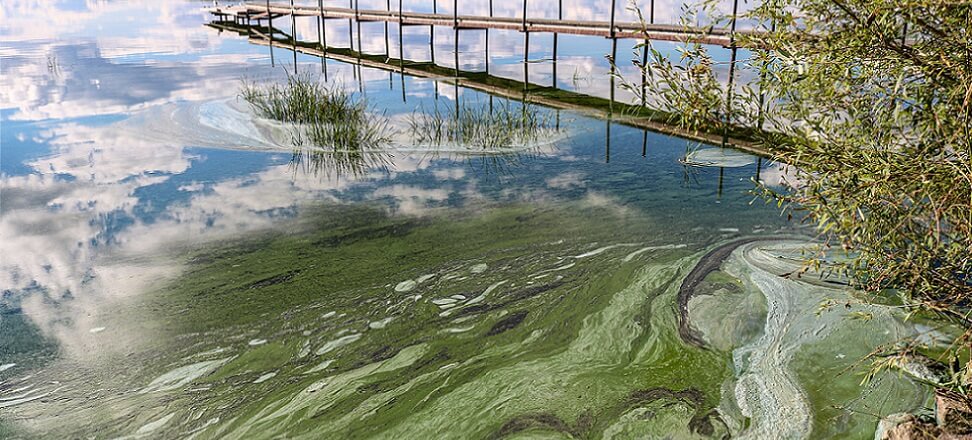So much has already been written about eutrophication that without getting into the details and scientific nuances, little new can be said about it. However, the downplaying of this problem in an issue of Water Issues devoted to the nitrate program could be read as a serious oversight. And why does eutrophication deserve our attention at all? Because it affects all waters, and the acceleration of this process, which has been observed for at least 60 years, is one of the biggest environmental problems worldwide.
Eutrophication means what?
Recognizing the phenomenon of eutrophication and defining it has a history of more than a century, although we are certainly still far from fully recognizing all its aspects. The first classifications of waters in terms of productivity and nutrient abundance were established in the 1920s. Last century, when German limnologist Naumann introduced the terms “oligotrophy” to describe waters with poor phytoplankton and “eutrophy” for waters with abundant phytoplankton. Subsequent work by Naumann and other researchers, most notably Thienenman or Vollenweider, developed these ideas, linking ecosystem productivity levels to nutrient concentrations and morphometric conditions. Many definitions of eutrophication have been formulated, mainly in the 1970s. They were developed in the 1970s, and are often highly nuanced. However, they all point toward one thing: eutrophication is the process of increasing the biological productivity of an ecosystem due to the enrichment of waters with nutrients. In general, it leads to an increase in the fertility of the aquatic ecosystem, from a poor state (oligotrophy) to an overfertilized state (hypertrophy).
The Eurofusion of water is a natural process, occurring on a geological scale. It involves a gradual, usually slow, increase in water abundance as a result of the supply of external matter, leading from oligo- through meso- to eu- and hypertrophy, and eventually to shallowing and transformation of the water body into a marsh and then terrestrial ecosystem. The pace of the process depends on the morphometry of the site (water capacity) and catchment conditions, and the course is by no means necessarily linear, from oligo- to hypertrophy, as confirmed by numerous paleolimnological studies. Periods of eutrophication can be interspersed with periods of oligotrophication and re-growth of fertility, and the direction of change and the duration of each stage depend on the susceptibility of rocks to weathering and leaching processes, soil-forming processes, changes in the vegetation cover on land and in the reservoir itself, and climatic factors.
The problem is that this natural process is superimposed on human activity, which modifies and accelerates it to a great extent, causing the so-called “natural process”. Cultural (anthropogenic) eutrophication. This phenomenon is as old as Homo sapiens, but it has increased significantly in the last 60 years, and the waters are undergoing an accelerated process of eutrophication. In many areas of the world, lakes that would most likely be oligo- or mesotrophic today without human intervention are transitioning to a eutrophic state, and those that are eutrophic are moving dangerously toward hypertonicity. And here we come to the idea of distinguishing between trophic state and ecological state.
Is eutrophic water always zeutrophic water?
For decades, it was customary to look at an aquatic ecosystem through the prism of its trophic state, where the most desirable state was that of low trophic status. And it wasn’t until the ecosystem approach to water assessment, introduced at the end of the 20th century and promoted by, among others. by the U.S. Clean Water Act, 1972, or the European Water Framework Directive (2000), has turned the tables. The concept of trophy itself has not changed, but already its perception has changed fundamentally. The assumptions of the “framework” made it possible to move away from the dogma: “oligotrophy good, eutrophy bad,” giving priority when assessing aquatic ecosystems to their potential (not to be confused with “ecological potential assessment”), resulting from natural conditions. This is because you can’t put the same quality requirements on high-mountain streams on silicate substrates and large lowland rivers in estuarine sections, or on large, deep alpine lakes and small, shallow, overgrown ponds. In this approach, eutrophic condition does not mean bad, provided that it is not the result of human activities and is due to the inherent characteristics of the ecosystem. The question that must be answered, then, is what the ecosystem would be like if the effects of anthropogenic pressure were not superimposed on natural processes. And this is the question that often underlies the establishment of what in water management we call reference conditions, or the reference state against which we judge the current state of water.
The criteria for assessing the ecological status of lakes currently in use in Poland indicate as limit values for phosphorus concentrations (depending on the water type) 50 or 60 µg l-1 for good status and 30 or 40 µg l-1 for very good status. In the commonly used systems for assessing water trophy, these values basically correspond to “early” eutrophy. Of course, for large, deep alpine lakes on granite bedrock, such criteria would be unacceptable, and it would be hard to believe that such phosphorus concentrations support their good condition. However, in the Polish lowlands, where relatively small lakes with well-buffered, highly alkaline waters, founded on rich glacial till of the last glaciation, predominate, it turns out that the eutrophic state can be as acceptable as possible (those interested in how to determine such limits are referred to the studies). The fact that eutrophic lakes exist “by nature” is confirmed by numerous paleolimnological studies. In this context, the question “is eutrophic water always zeutrophic water?” is based on a similar semantic nuance as, for example, whether salt water is the same as saline water.
Can eutrophication be controlled?
All this does not change the fact that waters today are subjected to tremendous pressure and their trophic (and ecological) state is not at all due to nature, but is the result of multiple anthropogenic influences. If we want to reduce the risk of increased plankton blooms and, above all, dangerous cyanobacteria (blue-green algae), we must take measures to rationally manage the amount of nutrients entering the waters.
The species composition and growth rate of phytoplankton communities are largely determined by the stoichiometry of nutrients, that is, the ratio of nitrogen and phosphorus (as well as carbon). This ratio tells which element is the limiting factor for algal growth and should be limited to prevent excessive biomass growth. The essential role of phosphorus in controlling algal blooms was demonstrated, among other things, by a series of experiments conducted in the 1970s. last century by Schindler and co-authors on the Experimental Lake Area complex in the Canadian province of Ontario. The researchers added controlled doses of macronutrients in specific ratios to the lakes’ waters and observed the long-term effects of these treatments. One of the more famous and spectacular experiments is the one conducted on Lake 226, which was divided in half by a tight barrier. Half of the lake was fertilized with controlled doses of carbon and nitrogen, and the other with carbon, nitrogen and phosphorus. As a result, an algal bloom developed only in the second part. Since those studies, there has been a fairly widespread consensus that the limiting element for phytoplankton in inland waters is phosphorus. However, it turns out that for most ecosystems, especially in an era of widespread water overfertilization, reducing the supply of just one of the nutrients most often has no lasting effect. The study by Paerl and co-authors, published in 2016. in the pages of Environmental Science & Technology, point out that the transformation of nitrogen forms by denitrification (the reduction of nitrogen compounds to gaseous form) and the fixation of nitrogen from the atmosphere by cyanobacteria must also be included in the overall nutrient budget. Based on an extensive review of the issue, the authors showed that phosphorus-only restriction is only effective in cases where the N:P ratio from the external supply is greater than 23, and in addition, nitrogen fixation predominates over denitrification or these processes are in balance. Nitrogen limitation, on the other hand, has the expected effect only in situations where algal growth is nitrogen-limited, that is, the N:P ratio is less than 9, and denitrification is comparable to or greater than the rate of nitrogen fixation from the atmosphere. In all other cases, control of the external supply of both nutrient elements is required to limit excessive increases in ecosystem productivity, including the risk of cyanobacterial blooms.
And in what way? That’s why we have regulations on agricultural fertilization (the main source of nitrogen compounds, though not exclusively) or municipal management (the main supplier of phosphorus). Are they effective and to what extent? It’s hard to say. Either way, there is no other solution to stop or slow down (and, if we try hard, maybe even reverse) the process of eutrophication than to reduce the loads of nutrients entering the waters. Studies from Western and Northern European countries that have made the effort to significantly reduce nutrient loads entering waterways decades ago (even since the 1960s) indicate that the process of oligotrophication is possible, and that the effects of water over-fertilization can be reversed to some extent. In Poland, so far we have not had spectacular achievements in this area, but if we do not apply strictures and restrictions, hyperthorax will catch up with us sooner than we think.

 Polski
Polski






